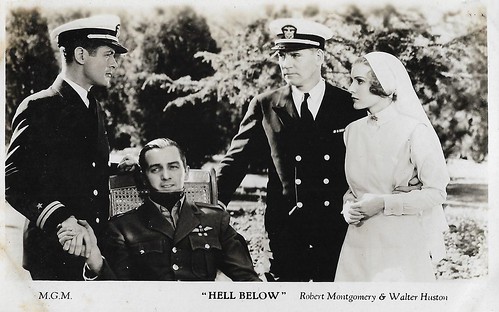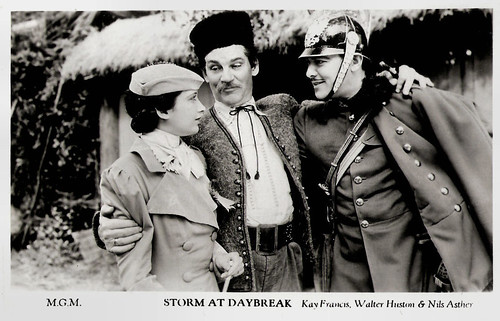
Spanish postcard by Dünmatzen, no. 44. Photo: Universal.

Vintage postcard. Photo: United Artists. Walter Huston as Doc Holliday in The Outlaw (Howard Hughes, Howard Hawks, 1943).

British postcard in the Picturegoer Series, London, no. 654.
A power station engineer in Nevada
Walter Huston was born Walter Thomas Houghston (Huston) in Toronto, Canada, in 1883. He was the son of Elizabeth (née McGibbon) and Robert Moore Houghston (Huston), a farmer who founded a construction company. He attended Winchester Street Public School. Huston studied engineering and worked in construction. In his spare time, he attended the Shaw School of Acting.
He made his stage debut in 1902. He went on to tour in 'In Convict Stripes', a play by Hal Reid, father of Wallace Reid. Huston also appeared with Richard Mansfield in 'Julius Caesar.' He again toured in another play, 'The Sign of the Cross'. By 1905, he was already a well-known stage name and received his first offer to perform on Broadway.
In the same year, he married Rhea Gore, a sports editor for various publications. After the birth of their son, John Huston, in 1906, Huston quit the stage to support his new family. He worked as a power station engineer in Nevada, Missouri. In 1909, after one nearly disastrous engagement (a reservoir he worked on proved flawed and nearly flooded a town) and with his marriage foundering, he returned to Vaudeville. He appeared with an older actress named Bayonne Whipple (stage name of Mina Rose), billed as 'Whipple and Huston'.
In 1913, he divorced his wife and the following year, Huston married Bayonne Whipple. Vaudeville was their livelihood into the 1920s, and Walter's son John was sent to live and study in boarding schools. In 1924, he finally made his Broadway debut with the play 'Mr. Pitt' by Pulitzer Prize-winner Zona Gale. Shortly afterwards, he was celebrated for his sensational performance as Ephraim Cabot in 'Desire Under the Elms' by Eugene O'Neill. It ran for 420 performances. Huston would remain one of the Nobel Prize-winning playwright's favourite actors.
The career of Bayonne Whipple (a.k.a. Mina Rose) did not follow the same trajectory as Huston's, and their marriage collapsed after Huston began to accept solo work. After several years of separation, the two divorced in 1931. Huston solidified his Broadway career with roles in productions such as 'Kongo', 'The Barker', and 'Elmer the Great'. In 1929, at the height of his Broadway fame, he joined the exodus to the West Coast where the talkies created an earthquake in the film industry.

British postcard by Film Weekly, London.

British postcard by Film Weekly. Photo: MGM. Walter Huston, Karen Morley and Franchot Tone in Gabriel over the White House (Gregory La Cava, 1933).

British postcard by Film Weekly. Photo: M.G.M. Walter Huston, Karen Morley and Franchot Tone in Gabriel over the White House (Gregory La Cava, 1933). Left: Huston, in the back, centre: Tone, right, sitting: Morley.
A major player in Hollywood
From 1929 Walter Huston worked as a film actor in Hollywood where he was cast in both character roles and as a leading man. He 'made his film debut in Gentlemen of the Press (Millard Webb, 1929) alongside Kay Francis. His first major role was the villainous Trampas in The Virginian (Victor Fleming, 1929), a Western that costarred Gary Cooper and Richard Arlen.
Huston played the martyred 16th U.S. president in D. W. Griffith's film biopic Abraham Lincoln (1930). Though Griffith's film was a flop, Huston had established himself as a major player in Hollywood. William Randolph Hearst's Cosmopolitan Productions cast him as super-tough Irish American police chief Jim Fitzpatrick in the crime classic The Beast of the City (Charles Brabin, 1932), with Jean Harlow as the moll who corrupts his kid brother. Jon C. Hopwood at IMDb: "It was one of Huston's most memorable early roles and showcased his superb talent for underplaying while conveying great emotion."
His other early sound roles included the virtuous banker in Frank Capra's American Madness (1932), the antagonist of Sadie Thompson (Joan Crawford) in Rain (Lewis Milestone, 1932), and the corrupt politician who transmogrifies into a righteous U.S. President in Gabriel Over the White House (Gregory La Cava, 1933), produced by William Randolph Hearst. The rather bizarre Gabriel Over the White House was seen as an advertisement for the politics of Franklin D. Roosevelt.
Dissatisfied with the roles he was given, he returned to Broadway, where he celebrated his greatest success to date with 'Dodsworth' by Sinclair Lewis. In the film adaptation Dodsworth (William Wyler, 1936), he reprised his role as a successful industrialist who must overcome a life crisis after discovering that his wife (played by Ruth Chatterton) no longer loves him. For his intense performance, Huston won the New York Film Critics' Award for Best Actor in 1936. The film was critically praised and nominated for seven Academy Awards, including Best Picture, Best Actor for Huston, and Best Director for Wyler, and won for Best Art Direction.
Huston had even greater success as a stage actor in the musical 'Knickerbocker Holiday', written by Kurt Weill (music) and Maxwell Anderson (book and lyrics). Playing Peter Stuyvesant, Huston sang the song 'September Song', which became his signature tune and is now considered a pop standard. Huston made an uncredited cameo appearance in the Film Noir classic The Maltese Falcon (John Huston, 1941). He portrayed the dying sea captain who was shot just before delivering the statue to the office of Sam Spade (Humphrey Bogart). As a practical joke during filming, John had his father enter the scene and die in more than 10 different takes.

British postcard by Film Weekly. Photo: M.G.M. Robert Montgomery and Walter Huston in Hell Below (Jack Conway, 1933).

British postcard by Film Weekly. Photo: MGM. Robert Montgomery, Edwin Styles, Walter Huston, and Madge EvansMadge Evans in Hell Below (Jack Conway, 1933).

British postcard in the Filmshot Series, by Film Weekly. Photo: MGM. Kay Francis, Walter Huston and Nils Asther in Storm at Daybreak (Richard Boleslawski, 1933).
An experienced gold prospector
Walter Huston's film career alternated between leading roles and larger supporting roles. Among the highlights of his career were his performances as the devilish Mr. Scratch in The Devil and Daniel Webster (William Dieterle, 1941) - for which he got his second Oscar nomination, as the lover of Ona Munson's character in Josef von Sternberg's late work The Shanghai Gesture (1941) and as Vaudeville star Jerry Cohan in the musical Yankee Doodle Dandy (Michael Curtiz, 1942) opposite James Cagney. For the latter, he was again nominated for the Academy Award for Best Supporting Actor.
During the Second World War, he acted in several Allied propaganda films including Mission to Moscow (Michael Curtiz, 1943) and The North Star (Lewis Milestone, 1943). Both painted a rather romanticised picture of the Stalinist Soviet Union. He was also the narrator of several war documentaries. In 1945, he starred in the Agatha Christie film And Then There Were None (René Clair, 1945) as one of the characters who are taken to a mansion on a small isolated island off the coast of Devon and killed by the dozen.
His greatest acting achievement is considered his role as an experienced gold prospector in the Western The Treasure of the Sierra Madre (1948), directed by his son John Huston. In 1949, he won a Golden Globe as well as the Academy Award for Best Supporting Actor for his performance. Accepting his Academy Award, the elder Huston said, "Many years ago.... Many, MANY years ago, I brought up a boy, and I said to him, 'Son, if you ever become a writer, try to write a good part for your old man sometime.' Well, by cracky, that's what he did!"
His final film was the Western The Furies (Anthony Mann, 1950), in which he played Barbara Stanwyck's father. In 1950, shortly after completing the film, Huston died of an aortic aneurysm in Hollywood, two days after his 67th birthday. He was cremated. In 1960, a decade after his death, Huston received a star on the Hollywood Walk of Fame at 6624 Hollywood Boulevard.
Walter Huston founded a Hollywood dynasty. Besides his son, his grandchildren Tony, Anjelica and Danny Huston and his great-grandson Jack Huston are or were active in the film business. In 1998, Scarecrow Press published John Weld's 'September Song—An Intimate Biography of Walter Huston'. Jon C. Hopwood: "Due to his great talent and his understated style, his reputation has not suffered as has some other of his 'great actor' contemporaries of the 1930s, but rather, seems to have been burnished as time goes by, as the hot acting style of the past has been replaced by a cooler style that continues into the present."

British postcard in the Filmshots Series, by Film Weekly. Photo: MGM. Nils Asther, Kay Francis and Walter Huston in Storm at Daybreak (Richard Boleslawski, 1933).

British postcard. Photo: Metro-Goldwyn-Mayer.

British postcard by Dover Publications Inc., 1986. Photo: Jeanne Cagney, James Cagney, Joan Leslie, Walter Huston and Rosemary De Camp in Yankee Doodle Dandy (Michael Curtiz, 1942).
Sources: Jon C. Hopwood (IMDb), Wikipedia (Dutch, German, French and English) and IMDb.
No comments:
Post a Comment